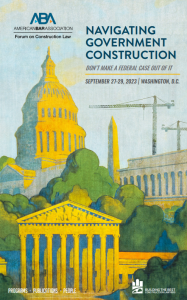![]()
Brian R. Zimmerman – Hurtado Zimmerman, SC and Rowan Mason – Ralls Gruber & Niece wrote and published the following article in the, the American Bar Association, The Construction Lawyer | Volume 42, No. 2 (February 2023)
Florida Enacts Law Requiring Structural Inspections of Condominiums in Wake of Surfside Collapse
Milestone Inspections
The law creates Section 553.899, under which all condominium associations[i] and cooperative associations[ii] (together “Association(s)”) are required to obtain a “milestone inspection” after 30 years, and then every 10 years thereafter, if the building is three or more stories in height.[iii] If the building is located within 3 miles of a coastline, the inspection must be after 25 years, and then every 10 years thereafter.[iv]
The milestone inspection must be completed by December 31 of the year in which the building reaches 30 years of age.[v] If the Association building is already older than 30 years, the milestone inspection must be completed before December 31, 2024.[vi]
Once a building reaches the age requiring a milestone inspection, the local enforcement agency must provide written notice to the Association, by certified mail.[vii] The Association must complete the “phase one of the milestone inspection” within 180 days of the notice from the local enforcement agency.[viii] Notwithstanding the notice requirement, the Association is responsible for arranging the inspection, ensuring compliance, and all costs of the inspection.[ix]
A “milestone inspection” is defined as a structural inspection of a building, including an inspection of load-bearing walls and the primary structural members and primary structural systems, by a licensed architect or engineer authorized to practice in the state, to determine whether the condition of the building is in compliance with the Florida Building Code or fire safety code.[x] The purpose of such inspection is to attest to the life safety and adequacy of the structural components of the building and to the extent reasonably possible, determine the general structural condition of the building as it affects the safety of such building. If necessary, a determination is to be made of any necessary maintenance, repair, or replacement of any structural component of the building.
There are two phases to the milestone inspection: Phase One and Phase Two.
For a Phase One milestone inspection, the architect/engineer must perform a visual examination of habitable and uninhabitable areas of a building, including the major structural components of a building, and provide a qualitative assessment of the structural conditions of the building.[xi] If the architect/engineer finds no signs of substantial structural deterioration to the building components upon visual examination, a Phase Two examination is not required.[xii]
A Phase Two inspection must be performed if any substantial structural deterioration is identified in the Phase One inspection.[xiii] A Phase Two inspection may be as extensive or limited as necessary to fully assess areas of structural distress in order to confirm the building is structurally sound and safe for its use, and to recommend a program for assessing and repairing distressed or damaged portions of the building.[xiv] A Phase Two inspection may involve destructive or nondestructive testing, at the inspector’s discretion.
All repairs as required under the Phase Two inspection must be commenced within 365 days after issuance of the report.[xv] If repairs are not commenced, the local enforcement agency may review and determine if the building is unsafe for human occupancy.[xvi] The local county commissioner may adopt an ordinance requiring a specific time to commence repairs.[xvii]
The Phase One and Phase Two inspection reports must be submitted with a sealed copy with a separate summary of the material findings and recommendations to the Association and to the building official of the local enforcement agency.[xviii] The report must include the following:
- Seal and signature of licensed architect or engineer who performed the inspection
- Indicate the manner and type of inspection
- Identify any substantial structural deterioration within a reasonable professional probability based on the scope of the inspection and describe the extent of any deterioration or recommended repairs.
- State whether unsafe or dangerous conditions exist under the Florida Building Code.
- Recommend any remedial or preventative repair for items that are damaged but do not meet the definition of substantial structural deterioration.
- Identify items requiring further inspection
The Association must distribute a copy of the reports to each unit owner, regardless of the findings or recommendation, must post in a conspicuous place on the property, and post on the Association’s website, if required.[xix]
Structural Integrity Reserve Study:
In addition to the inspection requirements, the law further requires that Associations complete a “structural integrity reserve study” by December 31, 2024, and then at least every 10 years thereafter for every building three stories or more.[xx] The structural integrity reserve study is required to identify the common areas being visually inspected, The structural integrity reserve study must at a minimum include: Roof, load bearing walls, floor, foundation, fireproofing, fire protection systems, plumbing, electrical systems, waterproofing, exterior painting, windows, and any other items that has a deferred maintenance expense or replacement cost that exceeds $10,000 and the failure of such item would negatively impact the other listed items.[xxi]
The structural integrity reserve study must state the estimated remaining useful life and the estimated replacement cost or deferred maintenance expense of the common areas and provide a recommended annual reserve amount that achieves the estimated replacement cost or deferred maintenance expense of each common area being visually inspected by the end of the estimated useful life of each common area.[xxii]
Structural reserve studies must be maintained for at least 15 years after the study is completed and are open to inspection by Association members at all reasonable times and available through the Association’s website.[xxiii]
As of December 31, 2024, an Association must provide for reserves for the amount estimated based upon the estimated useful life and replacement or deferred maintenance costs of items identified in the structural integrity reserve study.[xxiv]
An Association is not permitted to decline to reserve or under reserve any such amounts.[xxv] Also effective December 31, 2024, Associations may not vote to use reserve funds, or interest thereon, that are reserved for items identified in the structural integrity reserve study.[xxvi]
An Association’s failure to complete the structural integrity reserve study or willful and knowing failure to have a milestone inspection performed, constitutes a breach of an officer’s and director’s fiduciary relationship to the unit owners.[xxvii]
[i] As defined in Chap. 718 Fla. Stat.
[ii] As defined in Chap. 719 Fla. Stat.
[iii] Fla. SB 4-D (2022); §553.899(3), Fla. Stat.
[iv] Id.
[v] Id.
[vi] Id.; §553.899(4), Fla. Stat.
[vii] Id.; §553.899(5), Fla. Stat
[viii] Id.; §553.899(6), Fla. Stat.
[ix] Id.; §553.899(3), Fla. Stat.
[x] Id.; §553.899(2)(a), Fla. Stat.
[xi] Id.; §553.899(7)(a), Fla. Stat.
[xii] Id.
[xiii] Id.
[xiv] Id.
[xv]Id.; §553.899(11), Fla. Stat.
[xvi] Id.
[xvii] Id.
[xviii] Id.; §553.899(8), Fla. Stat.
[xix] Id.; §553.899(9), Fla. Stat.
[xx] Id.; §719.106(1)(k), Fla. Stat.
[xxi] Id.; §718.103(g)(1.), Fla. Stat.
[xxii] Id.; §718.103(25), Fla. Stat.
[xxiii] Id.; §718.111(12)(a)(15), Fla. Stat
[xxiv] Id.; §719.106(1)(j), Fla. Stat
[xxv] Id.; §719.112(2)(f)(2.a.), Fla. Stat.
[xxvi] Id.; §719.112(2)(f)(3), Fla. Stat.
[xxvii] Id.; §718.112(2)(h), Fla. Stat

 Construction attorneys should be familiar with intellectual property principles and copyright matters associated with their clients’ businesses. In part 1 of this two-part series, Bryan Kroes provides an introduction to copyright and how it intersects with construction projects.
Construction attorneys should be familiar with intellectual property principles and copyright matters associated with their clients’ businesses. In part 1 of this two-part series, Bryan Kroes provides an introduction to copyright and how it intersects with construction projects.